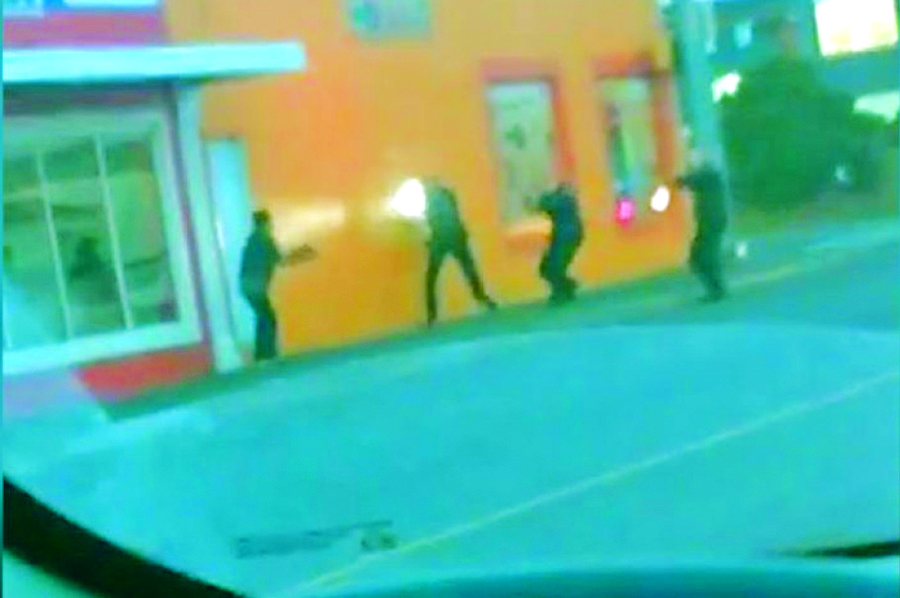EXCHANGE ON GUNFIRE
Last week, Rick Anderson wrote about the video that shows unarmed farmworker Antonio Zambrano-Montes being shot by Pasco police (“The Pasco Moment: Police, Lies, and Videotape,” March 4, 2015). “I’ve watched it several dozen times,” Anderson wrote. “It looks like manslaughter caught on tape.” The video appears to present overwhelming evidence of the kind of abuse that activists have decried following numerous recent deaths of unarmed men, in particular Michael Brown in Ferguson, Mo., this past summer. But for some, it wasn’t evidence enough.
Some vids leave the shooting open for debate. This one closes it. Whatever did happen up to that moment, there’s no justification for shooting a man with his empty hands stretched out. Maybe he was wounded in such a way he couldn’t raise them?
Donte, via seattleweekly.com
His hands must be up and open. The lack of that in the Brown case is one of the reasons the U.S. Department of Justice cited in not charging [Officer Darren] Wilson.
One of the things as I review the video as Zambrano-Montes flees from the corner, after he and the officers have crossed the street, is that his left hand appears to be open and up (as if gesturing). The right hand appears to be closed. Caveat, the video quality is poor. Is he holding a rock in the right hand? During the foot pursuit from the corner, he seems to turn on several occasions and furtively throw and not release at officers. He moves the right hand past his waist on several occasions. Even if you discount the possibility of a rock and accept that his hands are open and empty as he turns to the officers, is that turn—hands open and arms toward officers—an act of surrender or an attempt to close with the officers and try and wrestle them for their weapons? As a legal matter, the benefit goes to the officers, or a citizen, if they draw conclusions of threat from Zambrano-Montes’ actions. Their conclusion only need be reasonable. Georgenf, via seattleweekly.com
He may or may not have had a rock, but so what? Is that grounds for murder? Large rocks are easily dodged when thrown. I’ve done so myself before, and I’m not even a police officer. I just wonder where all those other unsafe shots came to rest? Luckily not an innocent bystander (this time) or we would have heard about it. But really?
Three officers with body armor, tasers, pistols, and I’m guessing at least one long gun in the trunk between the three, and they have to chase him and shoot him? Couldn’t they have hit him in the head with the gun? No? Maybe shot him in the leg or arm with one of those 13 shots fired at rush hour in downtown Pasco?
Oh, that’s right, police officers don’t have the skill or restraint to place other than a head shot or center of mass multiple times. There’s no way three trained officers could ever shoot an unarmed man to disable, “that’s not how they’re trained.” I mean, I could shoot a man in the leg from 30 feet with a pistol, but maybe that’s because it would be murder if I shot and killed him.
Thebriang, seattleweekly.com
Being at risk of death is not a requirement for use of deadly force in Washington. Risk of “Great personal injury” is the criteria as is actual resistance to a felony (a rock being thrown at you is second degree assault). More important, officers or citizens have no legal obligation to retreat (or dodge) from any place they are lawfully entitled to be, before asserting self-defense.
Georgenf, via seattleweekly.com
The cops who had no duty to dodge did—though the rock never came close—then shot him in the back as he runs through the crosswalk. You see him limping in the crosswalk after he is hit. If he is holding a rock in his left hand, it is a small one, and his only remaining weapon against men who are actively trying to kill him. Doesn’t matter. As he raises his hands the cops murder him.
Brian Holbrook, via seattleweekly.com
E
Comments and letters have been edited for length and clarity.




